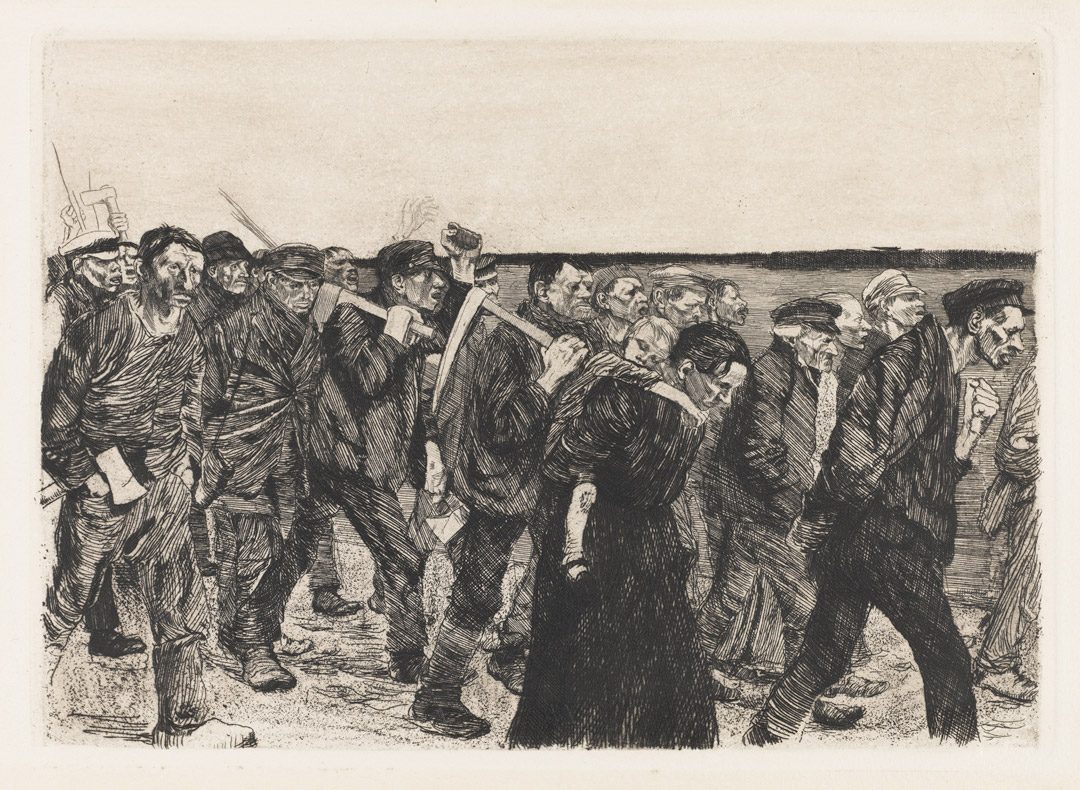Object of the Week: March of the Weavers

In 2015 SAM acquired this small—but powerful—etching by German artist Käthe Kollwitz. March of the Weavers is the fourth plate of six in a series Kollwitz called Ein Weberaufstand (The Rise of the Weavers). This series proved to be one of the most important works of her early career, as its public display in Berlin in 1898 catapulted her to national recognition. With the content of The Rise of the Weavers, Kollwitz was responding to a theatrical play by Gerhard Hauptmann, titled The Weavers, which told the story of an 1844 revolt over wages. In her diary, Kollwitz remembers the excitement and inspiration she gleaned from viewing that play, as well as the challenges she faced producing the series:
“A great event took place during this time: the Freie Buehne’s première of Hauptmann’s The Weavers. The performance was given in the morning. I no longer remember who got me a ticket. My husband’s work kept him from going, but I was there, burning with anticipation. The impression the play made was tremendous. The best actors of the day participated, with Else Lehman playing the young weaver’s wife. In the evening there was a large gathering to celebrate, and Hauptmann was hailed as the leader of youth.
“That performance was a milestone in my work. I dropped the series on Germinal and set to work on The Weavers. At the time I had so little technique that my first attempts were failures. For this reason the first three plates of the series were lithographed, and only the last three successfully etched: The March of the Weavers, Storming the Owner’s House, and The End. My work on this series was slow and painful. But it gradually came, and I wanted to dedicate the series to my father. I intended to preface it with Heine’s poem, ‘The Weavers.’ But meanwhile my father fell critically ill, and he did not live to see the success I had when this work was exhibited. On the other hand, I had the pleasure of laying before him the complete Weavers cycle on his seventieth birthday in our peasant cottage at Rauschen. He was overjoyed. I can still remember how he ran through the house calling again and again to Mother to come and see what little Kaethe had done. In the spring of the following year he died.”1
Kollwitz might have contented herself with the satisfaction of sharing her art with proud family members had it not been for the timely help of a friend:
“I was so depressed because I could no longer give him the pleasure of seeing the work publicly exhibited that I dropped the idea of a show. A good friend of mine, Anna Plehn, said, ‘Let me arrange everything.’ She entered the series for me, sent it in to the jury, and a few weeks later it was in the show at the Lehrter Station. Later I heard that the jury—Menzel was one of the members—had voted that the Weavers be given the small gold medal. The Kaiser vetoed the recommendation. But from then on, at one blow, I was counted among the foremost artists of the country. Max Lehrs, director of the Dresden collection of engravings and drawings, bought the series and succeeded in procuring the gold medal for it. To this day the Weavers is probably the best-known work I have done.”2
In The March of the Weavers and the series of which it is part, Kollwitz expressed solidarity with the working force. Her concerns were not only socio-political, but also aesthetic. Physical effort visualized in moving masses captured her imagination. For Kollwitz, celebrating workers became a cathartic release, one she would return to throughout her career:
“My real motive for choosing my subjects almost exclusively from the life of the workers was that only such subjects gave me in a simple and unqualified way what I felt to be beautiful. For me the Koenigsberg longshoremen had beauty; the Polish jimkes on their grain ships had beauty; the broad freedom of movement in the gestures of the common people had beauty. Middle-class people held no appeal for me at all. Bourgeois life as a whole seemed to me pedantic. The proletariat, on the other hand, had a grandness of manner, a breadth to their lives . . . And portraying them again and again opened a safety-valve for me; it made life bearable.”3
–Jeffrey Carlson, SAM Collections Coordinator